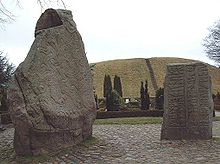
Vikings is the modern name given to seafaring people originally from Scandinavia, who from the late 8th to the late 11th centuries raided, pirated, traded and settled throughout parts of Europe. They also voyaged as far as the Mediterranean, North Africa, Volga Bulgaria, the Middle East, and North America. In their countries of origin, and some of the countries they raided and settled in, this period is popularly known as the Viking Age, and the term "Viking" also commonly includes the inhabitants of the Scandinavian homelands as a collective whole. The Vikings had a profound impact on the early medieval history of Scandinavia, the British Isles, France, Estonia, and Kievan Rus'.

Harald "Bluetooth" Gormsson was a king of Denmark and Norway.

Gorm the Old, also called Gorm the Languid, was ruler of Denmark, reigning from c. 936 to his death c. 958 or a few years later. He ruled from Jelling, and made the oldest of the Jelling Stones in honour of his wife Thyra. Gorm was born before 900 and died perhaps around 958 or possibly 963 or 964.

A runestone is typically a raised stone with a runic inscription, but the term can also be applied to inscriptions on boulders and on bedrock. The tradition began in the 4th century and lasted into the 12th century, but most of the runestones date from the late Viking Age. Most runestones are located in Scandinavia, but there are also scattered runestones in locations that were visited by Norsemen during the Viking Age. Runestones are often memorials to dead men. Runestones were usually brightly coloured when erected, though this is no longer evident as the colour has worn off. The vast majority of runestones are found in Sweden.

The Jelling stones are massive carved runestones from the 10th century, found at the town of Jelling in Denmark. The older of the two Jelling stones was raised by King Gorm the Old in memory of his wife Thyra. The larger of the two stones was raised by King Gorm's son, Harald Bluetooth, in memory of his parents, celebrating his conquest of Denmark and Norway, and his conversion of the Danes to Christianity. The runic inscriptions on these stones are considered the best known in Denmark. In 1994, the stones, in addition to the burial mounds and small church nearby, were inscribed on the UNESCO World Heritage List as an unparalleled example of both pagan and Christian Nordic culture.

Jelling is a town in Denmark with a population of 3,658, located in Jelling Parish, approximately 10 km northwest of Vejle. The town lies 105 metres above sea level.

The stone ship or ship setting was an early burial custom in Scandinavia, Northern Germany, and the Baltic states. The grave or cremation burial was surrounded by slabs or stones in the shape of a boat or ship. The ships vary in size and were erected from c. 1000 BCE to 1000 CE.

Norse funerals, or the burial customs of Viking Age North Germanic Norsemen, are known both from archaeology and from historical accounts such as the Icelandic sagas and Old Norse poetry.

Viking art, also known commonly as Norse art, is a term widely accepted for the art of Scandinavian Norsemen and Viking settlements further afield—particularly in the British Isles and Iceland—during the Viking Age of the 8th-11th centuries. Viking art has many design elements in common with Celtic, Germanic, the later Romanesque and Eastern European art, sharing many influences with each of these traditions.

Thyra, also known as Thorvi or Thyre, was a Danish queen, spouse of King Gorm the Old of Denmark, the first historically recognized King of Denmark, who reigned from c. 936 to his death c. 958 or c. 964.

The Christianization of Scandinavia, as well as other Nordic countries and the Baltic countries, took place between the 8th and the 12th centuries. The realms of Denmark, Norway and Sweden established their own Archdioceses, responsible directly to the Pope, in 1104, 1154 and 1164, respectively. The conversion to Christianity of the Scandinavian people required more time, since it took additional efforts to establish a network of churches.

Sønder Vissing I or DR 55 is a runestone located in the church of Sønder Vissing in eastern Jutland, Denmark. Sønder Vissing is a small settlement located in Horsens municipality approximately 20 kilometres (12 mi) south of Silkeborg, 20 kilometres (12 mi) west of Skanderborg and 40 kilometres (25 mi) northeast of the Viking monuments of Jelling.
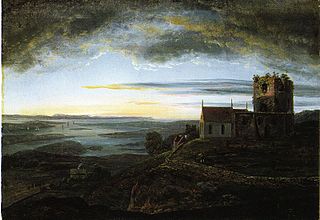
Avaldsnes is a village in Karmøy municipality in Rogaland county, Norway. The village is located on the northeastern part of the island of Karmøy, along the Karmsundet strait, just south of the town of Haugesund. The village was an ancient centre of power on the west coast of Norway and is the site of one of Norway’s more important areas of cultural history. The trading port of Notow and the Avaldsnes Church are two notable historic sites in Avaldsnes.

Triangle Region Denmark is a cooperation consisting of seven Danish municipalities on the Danish peninsula of Jutland and the island of Funen: Billund, Fredericia, Haderslev, Kolding, Middelfart, Vejen and Vejle.
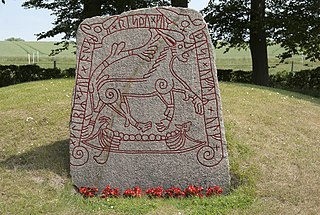
The Tullstorp Runestone is a Viking Age memorial runestone, listed as DR 271 in the Rundata catalog, that is located in Tullstorp, which is about twenty kilometers east of Trelleborg, Skåne County, Sweden, and in the historic province of Scania.

Tirslund Rock or Tirslundstenen is a glacial erratic in Denmark. Deposited during the Ice Age it lies 4 km west of Brørup. It is Jutland's largest granite boulder and the second largest in Denmark after the Damestenen. Its height is 3.5 metres above the ground and it is 16 metres in circumference. The weight is about 340 tons. The rock was put under protection in 1832.

The Danish House of Knýtlinga was a ruling royal house in Middle Age Scandinavia and England. Its most famous king was Cnut the Great, who gave his name to this dynasty. Other notable members were Cnut's father Sweyn Forkbeard, grandfather Harald Bluetooth, and sons Harthacnut, Harold Harefoot, and Svein Knutsson. It has also been called the House of Canute, the House of Denmark, the House of Gorm, or the Jelling dynasty.
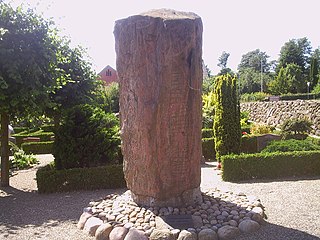
The Læborg or Laeborg Runestone, listed as DR 26 in the Rundata catalog, is a Viking Age memorial runestone located outside of the village hall or Forsamlinghus in Læborg, which is about 3 kilometers north of Vejen, Denmark. The stone includes two depictions of the hammer of the Norse pagan god Thor.

The Aars stone or DR 131 is a late Viking Age runestone located on a mound in the churchyard at Aars in Himmerland, Denmark. Dated to the late 10th to early 11th century, it bears an inscription in the Younger Fuþark in memory of Toke Gormsson, known as Valtoke, who died at the Battle of Fýrisvellir.
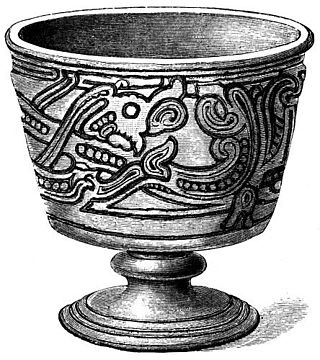
Gorm's Cup, also known as the Jelling Cup, is a small silver cup buried with the Danish king Gorm the Old, c. 958/959.
